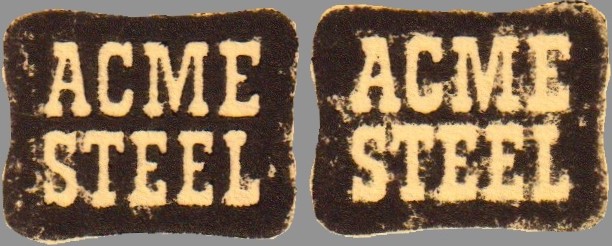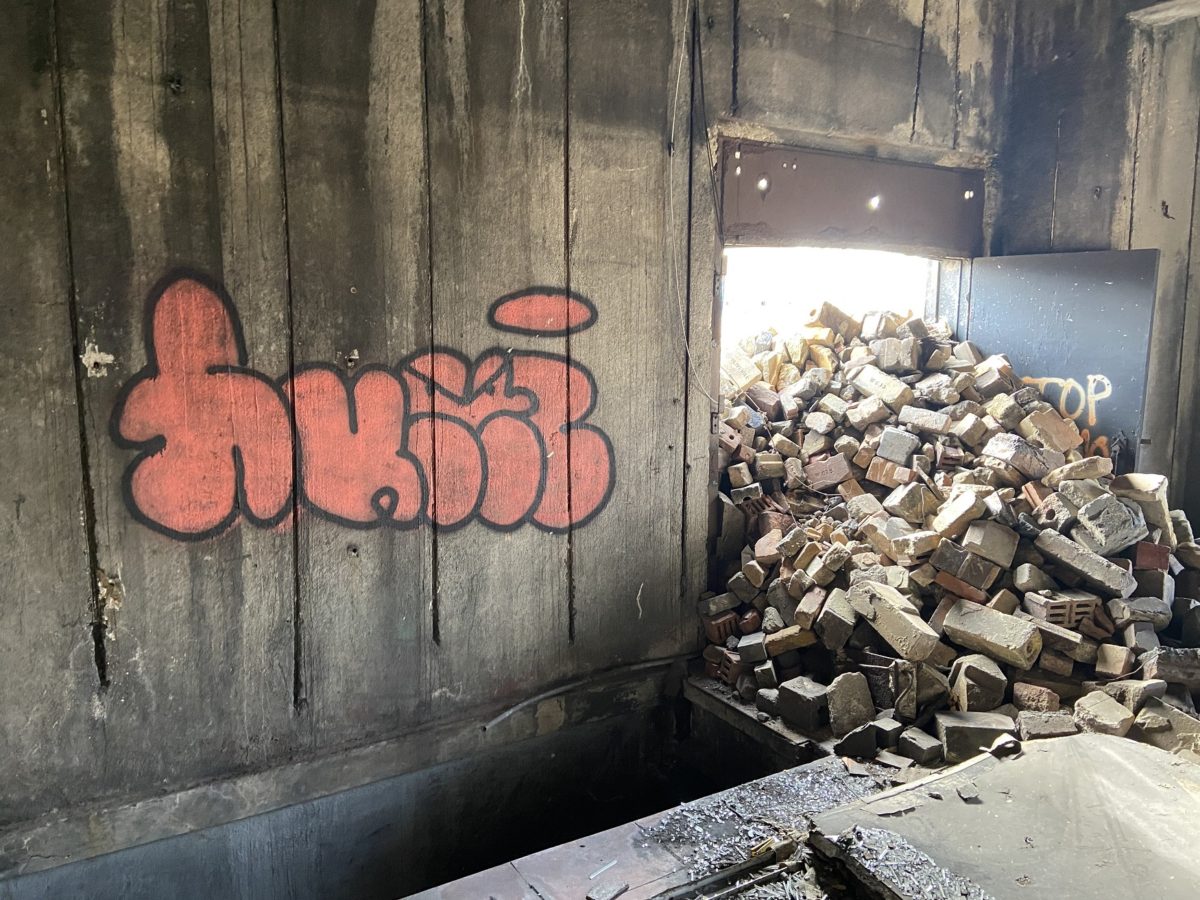Another Saturday with a singular plan – back to Acme I shall go. Had a couple loose missions in mind but felt a bit aimless – in the best way possible. The weather was in the balmy mid-30s range, I took advantage with an extended jaunt up Ave. O all the way to 100th before I headed back south. I took a mysterious service road I saw on Google Maps that brought me back to Muskegon and 106th, definitely something I will be doing again. There were some signs that said ‘KEEP OUT’ or ‘PRIVATE ROAD’ or something but I never have been a big reader.
I approached the plant from the north and decided to go through the gate house. I made it through and just as last week immediately saw two people – more visitors! They were about 200′ away near the main office. I called out to them but they didn’t hear me or ignored me. Neither would suffice so I walked over and as they turned I saw that again it was my friend FALS from last week but this time with a different companion. His friend had never been to the site before and he was bugging out at how huge it was. They said they had just gotten done with some new pieces in the second floor of the gate house. We all chatted for a while but before I took up too much of their time I got out of there. They said they would be in the main office doing their thing and I said I’d stop in later if they were still around.
My main mission was to explore the basement of the coal bunker. As the basement of battery #1 reached an end with some kind of cave in (natural or man made, still unsure) I am curious to see the other side of said cave in, and to see if a similar one exists for the basement of battery #2. There are two pits in the floor of the east side of the coal bunker ground floor. They are some kind of access panel I believe, as there is some kind of armature exposed. It was difficult to visually gauge how far down it was to the floor below which made me a bit nervous. Ironically, descending into pitch darkness doesn’t bother me much but I had a concern that I would not be able to pull myself back up. As much as I love Acme, getting trapped in an underground cavern is a bit much, even for me. I did toss some cinder blocks and lumber down there thinking I could build a step stool of sorts so I could reach the armature but in the end I decided to pass. I need to find much more building materials to cast into the pit before I go down there.
I did find some paperwork I never noticed. None of it was of any real interest but I found more of the strange circular seismograph type charts I found in the BP plant. At first I thought someone must have carried them over or something then I noticed a ton of them hanging on a wall! I don’t know if they used the same measurement equipment in both areas, or one area was used to store the finished reports?

My next mission was a fairly easy one. After restoring the open ended wrench (which I now know is a 1 1/4″) I took last weekend, I went back for the pipe wrench I had stashed. It was waiting for me beneath the pusher side of A25. This time I was smart enough to bring a garbage bag as the last wrench got rust all over my clothes and even my bike. I noticed that it is missing the heel jaw but I already located one on eBay for $5 that hopefully should fit. I brought it back to my shop and got it disassembled. I could not get the hook jaw removed initially, some WD40 helped free the nut but it only rotated about 1/4 turn. I tapped it with a hammer (which let loose a torrent of rust) but still did not release it. Would you believe I used another pipe wrench to get it apart? That ended up being a good solution. I got it soaking in some rust remover which I won’t be able to check for about 36 hours (it should do it’s job in 12). I’m sure I will still have to do some serious sanding but this should be a good head start. When I get this one done I will share some photos of each in their restored state, where they can live their years out in peace, hanging in my office as a reminder of the hard work they once did in an important historic site I love so much.
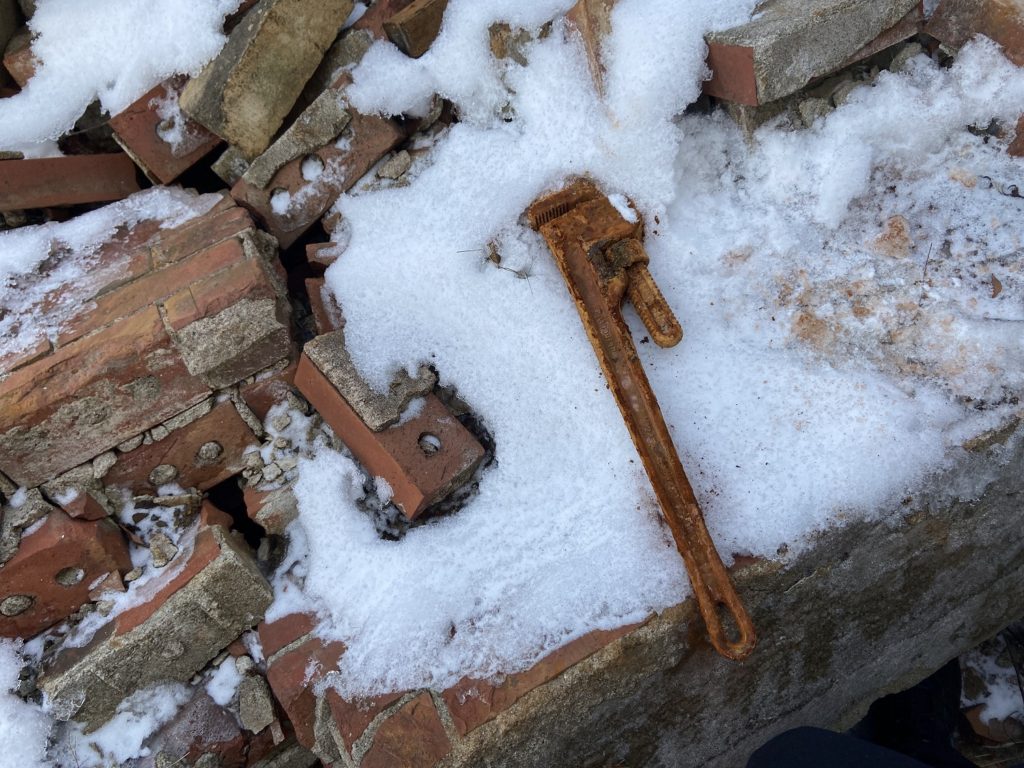
After that I started wandering. I didn’t feel like going inside the coal bunker so after pacing around the ovens area for a while I made a realization. This has happened once before (and it happened again later that day) – the ground floor of the coal bunker is divided in half, and the halves are not connected with any doorway. What I thought was the western exterior wall moments before was just a dividing wall. So I entered through one of the many openings on the west side and shook my head in disappointment of myself for not realizing this much sooner.

I did encounter some paperwork blowing around but initially nothing interesting. Unfortunately I did find a few examples of binders and loose papers that were totally ruined by the elements, clinging together as a dense cake of lost information. I found some others that were half disintegrated which was almost worse, you could just get a hint of what you were holding in your hand and what was lost.

But the trail was getting hot and I hoped that something better (and intact) was around the corner. A lot of the best stuff I have found was just blowing in the wind so I always know anything is possible. It wasn’t more than a few steps later that I found a binder, face down and half way open in a pile of filth. I picked it up and as I handled it the cover of the binder broke free. It has plastic sheets at the beginning and end to protect the pages inside the sandwich. I opened it up and the title told me all I need to know. I probably gasped and looked to find a place I could lay the book down and get a closer look.
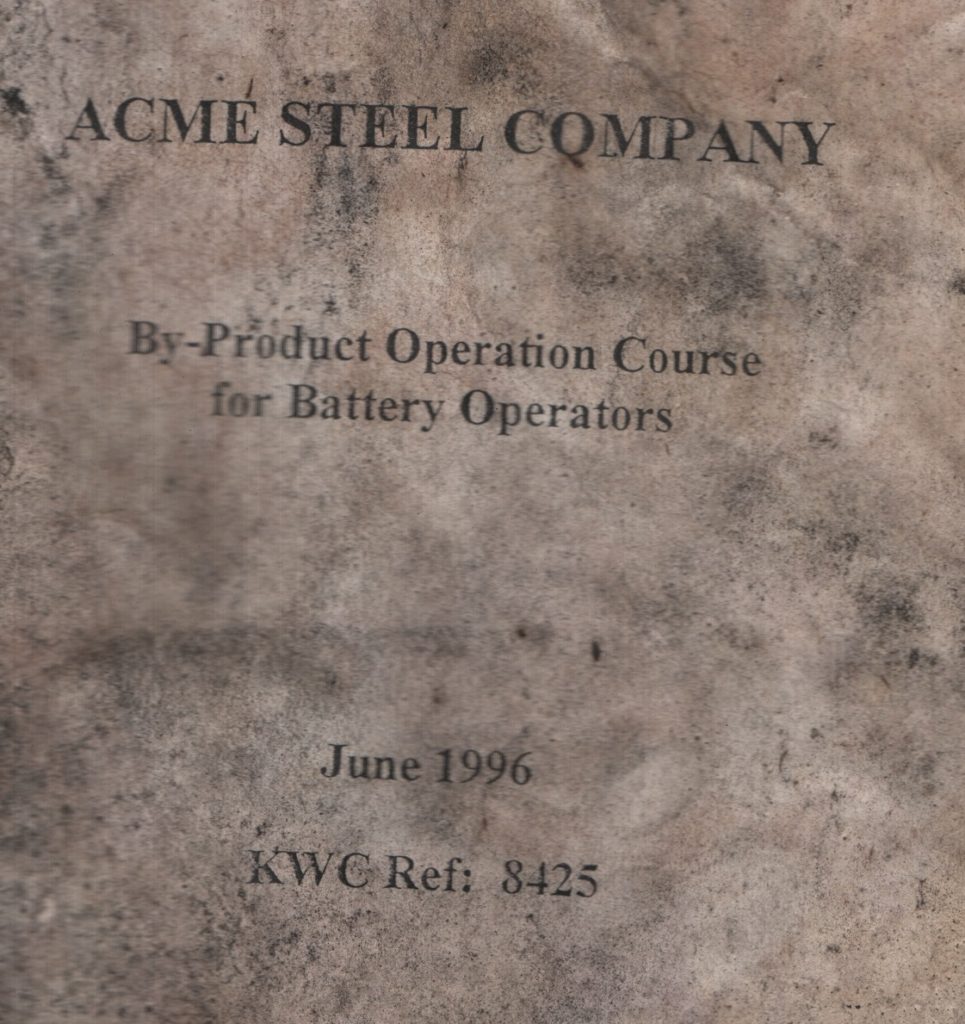
I have been dying for more information on the BP process and this was tailor made for me. Far from it for me to label myself as an oven expert but I have some kind of periphery understanding of how the coal gets to the batteries and what happens after. But the complex routing of volatile compounds to and fro, between the ovens and BP, and even the blast furnace a mile away is difficult to wrap my head around.
The pages were a bit water damaged and 15 years of heat and cold and humidity had begun to glue them together. Instinctively I started to try to tear them apart, half in a wonder if this text was worth bringing home, and half dying to see what was inside. I saw that a good portion was diagrams and what little text I could render just enticed me more. Luckily I had the sense to stop picking at the pages in such an uncontrolled environment. Interesting that one of the most important documents I have found looked to also become one of the most difficult to restore. I pried the severely rusty binder open and pulled the pages out and deposited them in my bag and tried not to think about it. My scanner was miles and hours away!
The last thing on my list was to head back to the locker room and the small coal handling office in the back. I pulled some interesting stuff out of there last time and had a feeling I might have missed something. I did find some pretty clean documents describing coal blends and a few pages devoted to foundry coke. The plant traditionally made coke for it’s blast furnace, foundry coke is a different breed and in the later days of the plant they were selling the product to other companies. I also again saw some 3.5″ floppy discs that I passed on last time. This time I scooped them all up, I came away with 5 or 6 (more on that later). I also found a folder stuffed with info on accident reports. They were in perfect condition and all were pre-Acme (before 1986). On Interlake letterheads, they warned department heads on numerous safety issues. Unfortunately, only about 25% of it is worth keeping, the rest are EXAMPLES of accidents. I certainly do not relish reading of death or dismemberment but many of these documents came with a cover page stating “none of these accidents occurred at Interlake plans”, and were just industry reports from around the steel industry. There were however a few worth keeping and they would account for some of the oldest documents in my archive, dating back to the mid 1970s. Very exciting stuff – glad I circled back to this building to have another look.
I headed back over to the main office to look for the artists but they were gone. The scent of paint was thick in the air so I let my nose guide me and found another great piece from FALS.

Then I reached a familiar moment in any visit, where I feel a real, true peace wash over me. You start to soak up the silence and never want to leave. I just wandered around for a long time. I walked as far north as I could, deep into the weeds and found the remains of a rail spur, which led very close to Torrence Ave. The rails were gone (scrapped I’m sure) but the wooden ties remained. I took a closer look at the tiny buildings right there along the fence line, north of the gate house. Again I realized I had been fooled into thinking I had fully investigated a ground floor but in fact it was divided and I didn’t know it. I found an amazing time capsule under the stairs of the remains of this building (these stairs literally lead to nowhere but a substantial fall should you climb to their top).

Unfortunately these all appear to be maintenance manuals for general machinery like pumps or electrical cabinets. I left them where they stood to continue to watch over the place. Later, I headed back to the BP area to look for more videotapes. There, I found 2 more sets of spools. One was still inside a cassette but it was cracked and fell apart in my hands. I packed them into my bag and moved on.
I got home and immediately disassembled the pipe wrench and got it into it’s bath. Then I sat down to work on getting this BP manual scanned. I felt like I was in the FBI, even after almost 600 pages scanned (and probably twice that handled) I had never had a challenge like this. The stakes were high, as what little I could see told me this was a very important document. Foolishly, I spent way too much time trying to separate all the pages. Using a knife and a straight edge, I even trimmed off the edges (the blank areas of the pages), as that is where they seemed to have adhered the worst. I tried using heat, then even heat and a little moisture (water spritzed from a bottle) and nothing helped very much. Eventually I figured out the best idea was to scan the top page, then peel it off like an onion. This would destroy the top page mostly, but as it was scanned I didn’t need it anymore. This went on for almost 50 pages, but after about 12 the condition got a bit better with much less tearing. Regretfully, I did make some of it worse with my early ill advised attempts but overall I think it was salvaged very well. I haven’t read the entire text yet but it is an excellent explanation of coke oven gas and how it is processed. There are 14 pages of diagrams at the end demonstrating some of the BP equipment and tanks but most interesting are the first two which are flowcharts showing the routing of pipes and tanks around the plant. The tanks are all gone but I do recognize many of the areas where they once stood, I look forward to my next visit and navigating them one by one with the flowchart in hand.
The last page was the best of all. It is a map (which even labels Torrence Ave) of most of the plant. As it focuses on the by-product plant, it crops out everything south of the coal bunker. It was folded in thirds as it is an 14″ legal size print. I was terrified as I worked on it, I knew I needed this badly for my own selfish purposes if not to preserve something historical. How this was not destroyed from years of sitting folded together is beyond me. Certainly it did not come away cleanly but more than good enough.
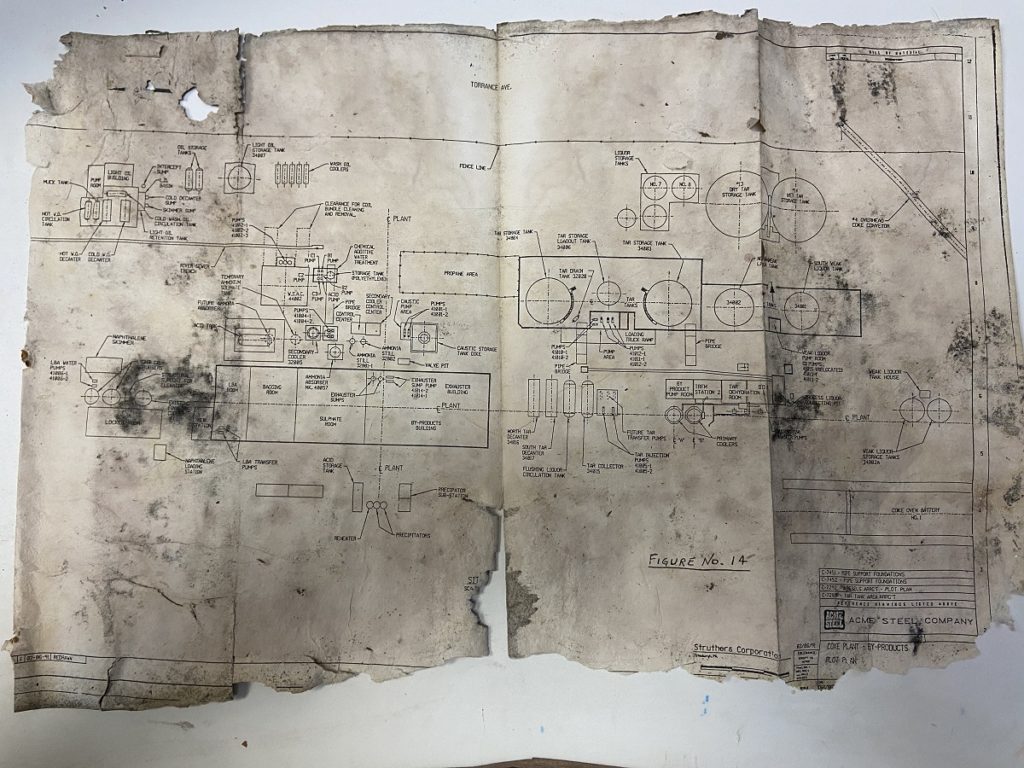
The videotapes were (spoiler alert) a total bust once again. Shocking!


The floppy discs should be interesting if they are not corrupted – and I can find a way to access them! I have not owned a computer that had a 3.5″ drive in years but I contacted a friend and he did have one. Alas it is internal and of course connects via IDE. My current PC does not have an IDE bus at all making connection impossible. Then I remembered I do have an IDE/SATA HDD enclosure. I did not have the correct Molex power cable but I was able to build one with the help of a soldering iron and some electrical tape.
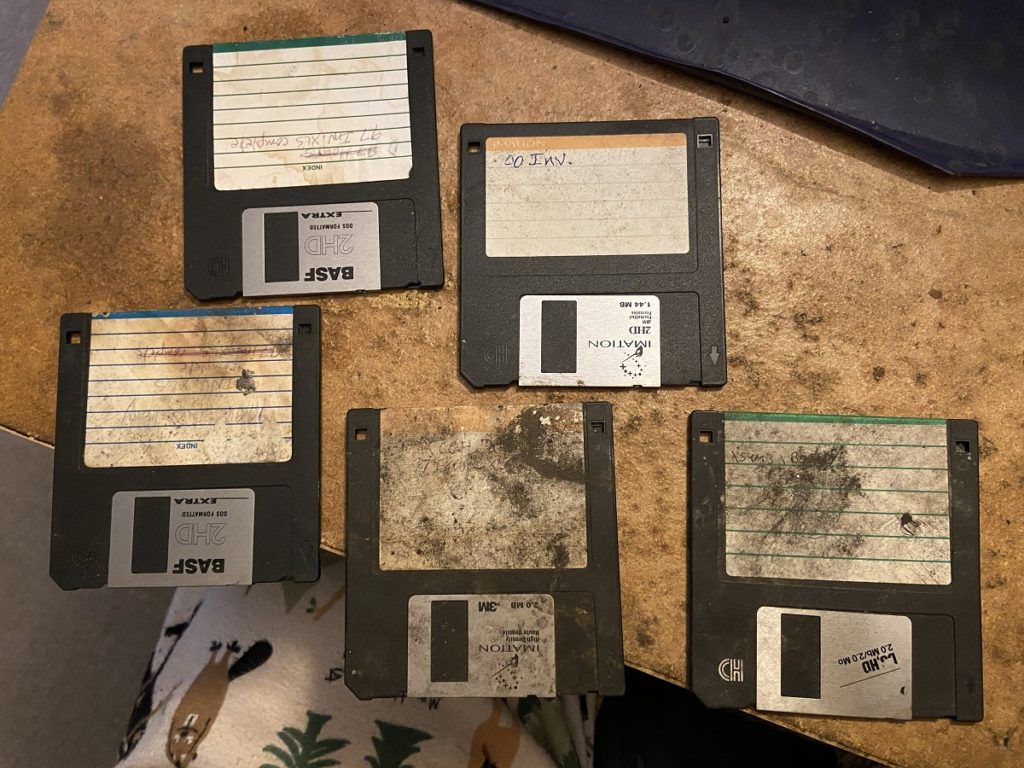
Then at the moment of truth I saw that HDDs and floppy drives do NOT use an identical IDE format (the HDD cable has more pins). So now I have ordered a USB external and will have it tomorrow. I used compressed air to clean off the discs, the media inside looks clean and all of them spin freely. One of them was quite dirty and I did discard it. Most of the labels are almost impossible to read but all make references to “inventory” or “INV” and a few reference XLS files. Expect some Google Sheets, the original files for download and PDFs. Fingers crossed…
A couple other documents taken from the coal handling office deserve attention. One is an excellent map of the facility. There were numerous copies stuffed in a folder, I’m guessing they were given to drivers so they could find their way around the plant. The bold lines are ‘paved’, the others are not. This map is super important historically as some of these paths/roads have been erased by time. Many of them I recognize, others I do not but they make sense to me now. I have cropped the map (the original is available in the Document Archive) and below I have a screenshot from Google Maps satellite view for comparison, which I have marked up to highlight the roads.


I also found a random email orphaned on the floor in the same office. I laughed a bit as some things never change – this sounds like an email I would send and a stupid mistake I might encounter (not that I am immune). Bear in mind the recipient is the assistant division manager. A few seconds after I began to wonder if Beemsterboer was a person or a company, strangely I found the sticker you see below a few inches away.


It feels good to know that Beemsterboer is still doing business in NW Indiana and the south side to this day and still run exclusively by a group that share the family name! Under the ‘services’ tab on their website it does of course still offer screening services – a critical step for anyone working in a coal handling office, like the fellow who’s desk I am investigating now, some 20 years later.
Even on the days I have the loosest itinerary, important work reveals itself. How long this continues, only God knows. Until then, you know where to find me Saturday morning. Saturday afternoon you’ll find me on Baltimore Ave eating a sandwich in my truck, hands stained with coal and filth and a head full of more ideas, more missions and more love for the place that brought me there.
[Footnote: I was not able to extract any data from the 3.5″ floppys I found. It may be that they were long since corrupted. However there was clearly some grit inside the disks as once they had spun up in the drive, I could see that the media was scratched. This crossed my mind when I was using compressed air to clean the outsides, as I did not want to drive dirt inside the cases. But either I did anyway, or it was already there. I did contemplate removing the media and putting it into another new, blank disk but I didn’t try. I’ll never know what was lost, but I am ready to try again as I am now stuck with this drive!]
